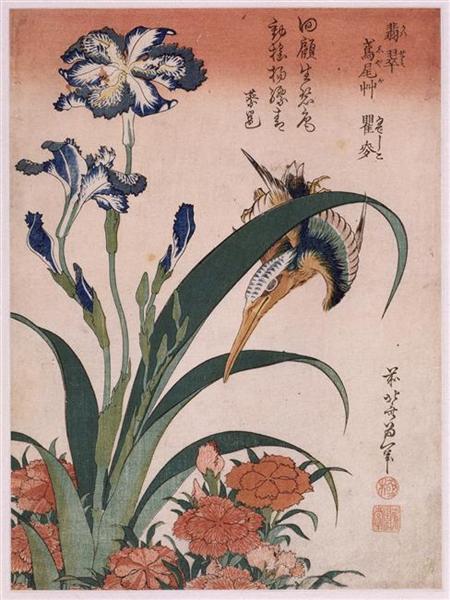Description
Katsushika Hokusai's "Kingfisher - Carnation - Iris", created in 1834, is one of the most significant manifestations of Japanese ukiyo-e mastery and reflects the artist's meticulous attention to detail in nature. Hokusai, famous for his landscapes and his reinterpretation of Japanese visual culture, shows in this painting a unique fusion between the representation of flora and fauna, highlighting the ephemeral beauty of both elements.
In the composition, the night heron is positioned as the focal point of the work. Hokusai's attention to this bird is palpable, its plumage contrasting vibrantly with the soft colours of the flowers. The night heron is portrayed with great precision, suggesting not only Hokusai's interest in birdlife, but also his desire to capture the essence of wildlife with an almost scientific approach. This type of depiction is not foreign to the artistic interests of the time, where artists were showing a growing fascination with the natural world.
The carnations and irises at the bottom of the painting provide a colour palette that complements the liveliness of the bird. The pink and lilac tones of the flowers contrast with the deep blue and green that predominate in the bird, creating a visual harmony that is characteristic of Hokusai's work. The use of colour in this work is not merely decorative; it is deeply linked to the emotion and atmosphere that Hokusai wished to convey. The choice of a neutral background, which accentuates the colours of the main elements, is a stylistic device that Hokusai frequently employed to allow the figures to stand out in the context of the work.
The arrangement of the elements in the work also deserves particular attention. Hokusai opts for a vertical frame, a decision that guides the viewer's gaze towards the heron, almost as if this were a moment that captures the interaction between the bird and its environment. The observer is invited to contemplate not only the aesthetic beauty of the objects depicted, but also their interrelationship. This dialogue between the heron and the flowers symbolizes the connection between humans and nature, a recurring theme in Japanese art.
It is relevant to mention the historical context of Hokusai, who was in full force during the Edo period and was a precursor to the most modern currents of Japanese art. His work, in this phase, reflects a moment of reflection and experimentation with nature, laying bare the complexity of the aesthetic and symbolic relationships that exist between living beings and their environment. Hokusai's penchant for observational details also resonates with the artistic movement of scientific observation that was growing during his time. In addition, the influence of ukiyo-e art lasted beyond Japan, leaving an indelible mark on Western art, particularly on Impressionism.
“Kingfisher – Carnation – Iris” is therefore a complex visual account of natural interaction; a testament to the prolificacy of an artist who not only mastered the technique of printmaking, but who, through his paintings, achieved a mastery that continues to inspire future generations. The richness of his palette, the virtuosity in the representation of natural life, and the subtle yet powerful visual narrative make this work a remarkable example of Hokusai’s ability to transcend the merely decorative, allowing viewers to discover a multidimensionality within what might seem a simple representation of nature.
KUADROS ©, a famous painting on your wall.
Hand-made oil painting reproductions, with the quality of professional artists and the distinctive seal of KUADROS ©.
Painting reproduction service with satisfaction guarantee. If you are not completely satisfied with the replica of your painting, we will refund 100% of your money.

